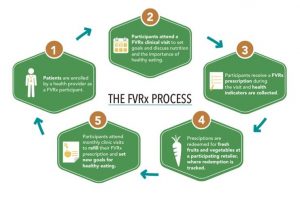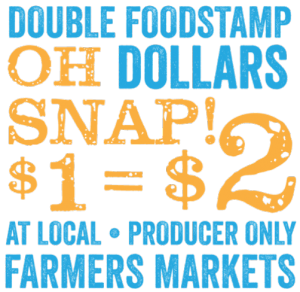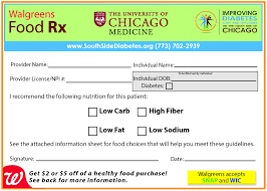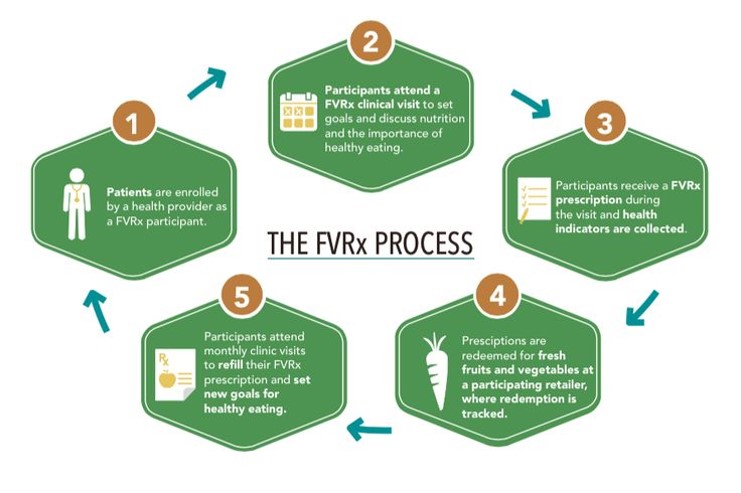Hippocrates is often quoted as saying, “Let food be thy medicine and medicine be thy food.” While some researchers argue that Hippocrates knew the difference between ‘real’ medicine and clinical therapy, there’s no doubt he appreciated the social determinant of health and wellness that food was 1,000 years ago and continues to be today.
 Taking a page, or prescription note, from the good doctor’s Rx pad, food retailers, healthcare providers, local food banks, and State healthcare programs are working the food-as-medicine connection to bolster public health.
Taking a page, or prescription note, from the good doctor’s Rx pad, food retailers, healthcare providers, local food banks, and State healthcare programs are working the food-as-medicine connection to bolster public health.
One approach to food-as-medicine is promoting the purchase of fresh fruits and vegetables — the Fruit-Vegetable Rx process, or FVRx, illustrated in the first diagram. This paradigm was conceived by Wholesome Wave, a not-for-profit that has a mission of getting fresh food to lower-income health citizens around the U.S. Wholesome Wave works with over 6,000 farmers throughout the U.S., has over 100 partners (hospitals, community health centers, and food hubs), and works with over 700 direct-to-consumer markets and retailers.

The organization has incorporated behavioral economics into its approach with consumers, who can double SNAP foodstamp dollars by buying local, fresh food from participating farmers. Earlier this month, Wholesome Wave received a $500,000 grant from the USDA for bolstering fresh food access in Connecticut and Vermont.
Washtenaw County, Michigan, sponsors the Prescription for Health program which connects patients who visit clinics in Chelsea, Milan and Ypsilanti to local farmers markets through health care providers. Providers write “prescriptions” for patients to eat more fruits and vegetables, redeemable at area’s farmers markets. Patients are given $10 tokens for fresh fruit and veg to be used over a 10-week period, for a total value of $100. Partners in the program are part of the St. Joseph Mercy health system and the University of Michigan health system, among other providers in the area.
On the r etailing front, Walgreens, the pharmacy chain, has been part of the FoodRx trend since 2012. The company provides coupons for healthy food and has worked in Metro Chicago since 2012 with the University of Chicago Kovler Diabetes Center and area clinics, to bolster healthy food purchases among its shoppers. See the “Food Rx” prescription pad page with the message, “Improving Diabetes Care and Outcomes on the South Side of Chicago.”
etailing front, Walgreens, the pharmacy chain, has been part of the FoodRx trend since 2012. The company provides coupons for healthy food and has worked in Metro Chicago since 2012 with the University of Chicago Kovler Diabetes Center and area clinics, to bolster healthy food purchases among its shoppers. See the “Food Rx” prescription pad page with the message, “Improving Diabetes Care and Outcomes on the South Side of Chicago.”
Health Populi’s Hot Points: Healthy food is a social determinant of health, and for consumers, food systems are local. But health policy is national and global, which public health professionals have recognized for decades.
What proponents of these FoodRx programs are leveraging is the power of locally-grown food. Not only are logistics favorable for this tactic, but food sourced closer to home tends to be healthier, less processed, and more “whole.”
Note the zero kilometers food movement in Italy, which I detailed here in Health Populi. The health of Italians in Italy tends to be among the most resilient on Planet Earth. Italians’ approach to food sourcing and eating is a key component of their longevity and long lives.
May farmers’ market and locally-sourced food continue to proliferate in local health markets in the U.S. More chain grocers and big box stores are launching local food sourcing programs. By doing so, these food retailers are promoting health in their regions, and customer loyalty among those shoppers who are health engaged. That turns out to be 8 in 10 food shoppers, so adopting local food sourcing is not only a nice-to-do sales tactic to attract shoppers to stores. It’s a smart-to-do tactic, as well, from a business strategy point of view.





 I am so grateful to Tom Lawry for asking me to pen the foreword for his book, Health Care Nation,
I am so grateful to Tom Lawry for asking me to pen the foreword for his book, Health Care Nation,  I love sharing perspectives on what's shaping the future of health care, and appreciate the opportunity to be collaborating once again with Duke Corporate Education and a global client on 6th May. We'll be addressing some key pillars to consider in scenario planning such as growing consumerism in health care, technology (from AI to telehealth), climate change, and trust -- the key enabler for health engagement or dis-engagement and mis-information. I'm grateful to be affiliated with the corporate education provider
I love sharing perspectives on what's shaping the future of health care, and appreciate the opportunity to be collaborating once again with Duke Corporate Education and a global client on 6th May. We'll be addressing some key pillars to consider in scenario planning such as growing consumerism in health care, technology (from AI to telehealth), climate change, and trust -- the key enabler for health engagement or dis-engagement and mis-information. I'm grateful to be affiliated with the corporate education provider  Thank you FeedSpot for
Thank you FeedSpot for